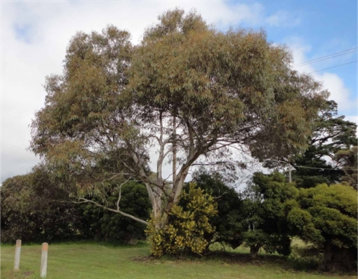
The outside of the red gum at this time of year is a profusion of blossoms. It vibrates with the sound of bees and flies and is cluttered with the squawks of Red Wattlebirds and the whistles of New Holland Honeyeaters. Now and then a Brown Honeyeater steals in to take of the spoils as well. Usually it is found out by a New Holland Honeyeater and briskly chased off, but at the moment there is much supply of nectar and all the birds that want a piece of the action are gleefully satisfied.
With the recent winds the tree has started to lose more branches which I why we ended up removing the three trees along the back fence line shortly after moving into the house. More fodder for the mulcher to add to the garden at Tillellen.

From what I can gather, this tree is a Eucalyptus leucoxylon rosea spp. It is quite different to the Corymbia ficifolia (formerly known as Eucalyptus ficifolia) which is actually a myrtle and is endemic to this area, though has been cultivated and distributed world-wide for landscaping.
The leucoxylon rosea are beautiful trees when pruned to a decent and safe shape, and full of wildlife when in flower. However, as has been our experience, they get a little too heavy at the ends given the limbs tend to stick out at angles and weaken and so have a tendency to break. March and April is the usual flowering time for this tree which gives the birds a good bit of feed prior to winter.
Red Wattlebirds, New Holland Honeyeaters and Brown Honeyeaters sound like bands from the 1980s. What is a red gum. What we know as red gum is Eucalyptus camadulensis, but there are also flowering red gum and red flowering gum, and a few others.
LikeLike
Ha ha! Thanks Tony. I’ve added a bit more to the post for the trees identity!
LikeLike